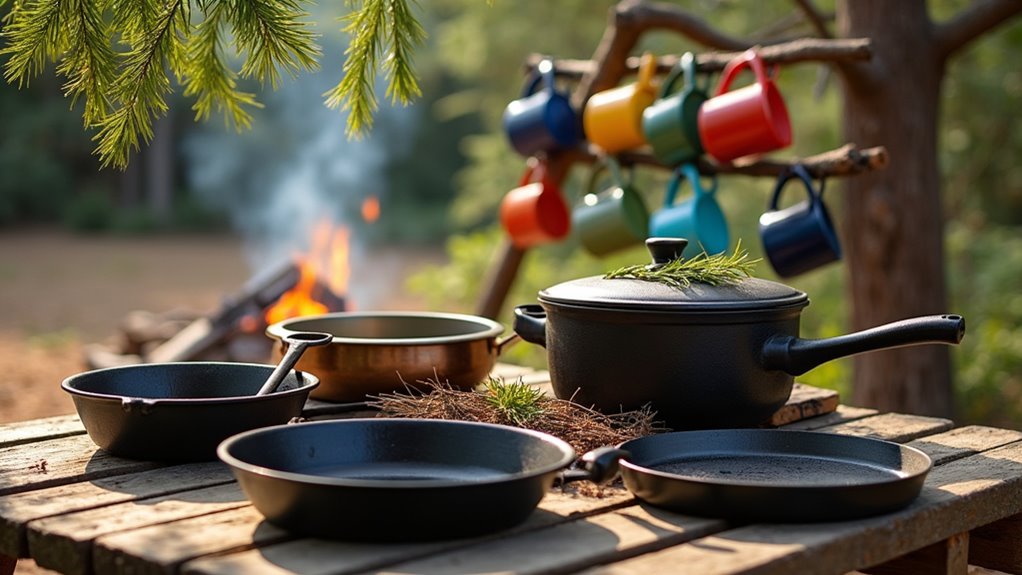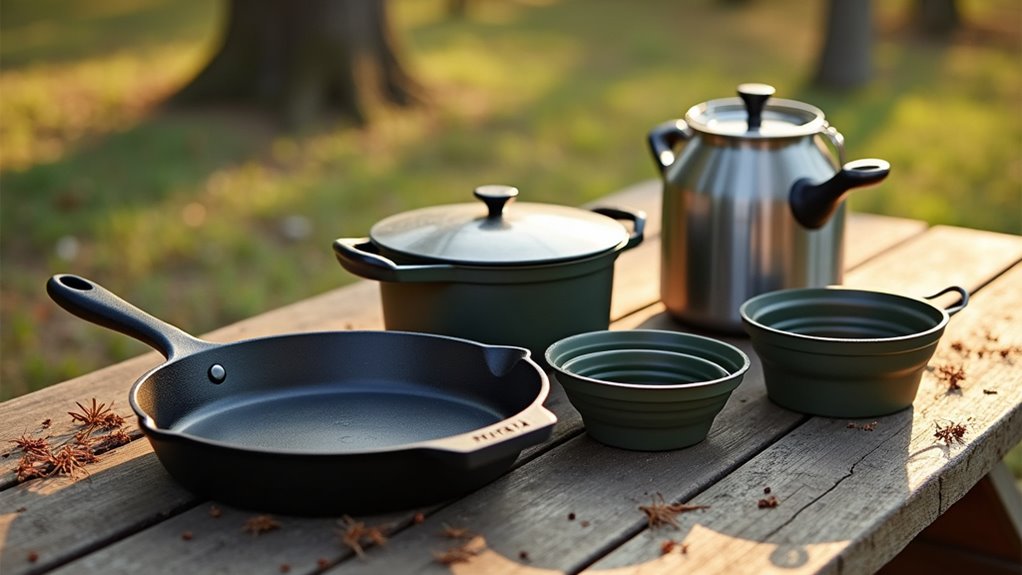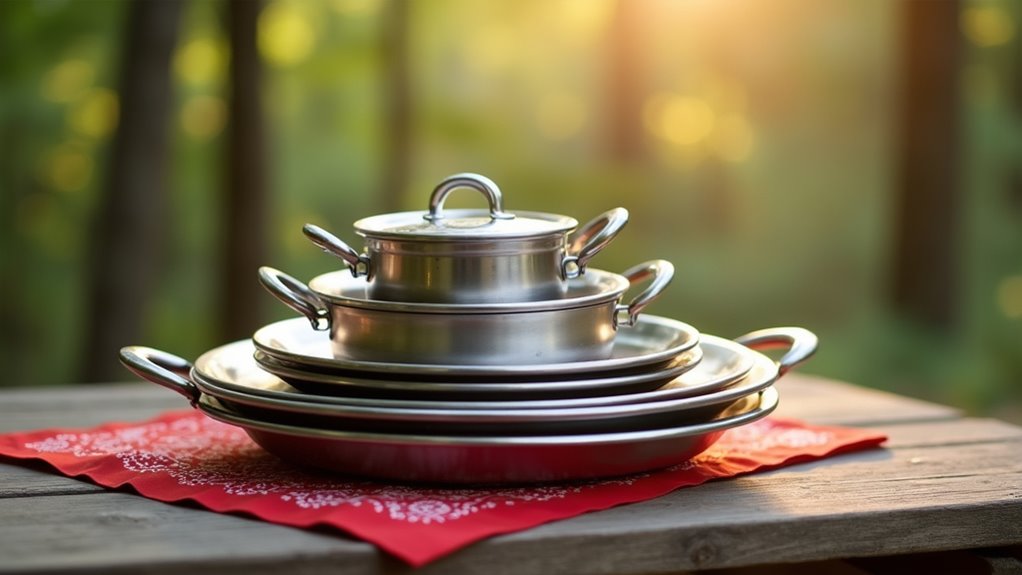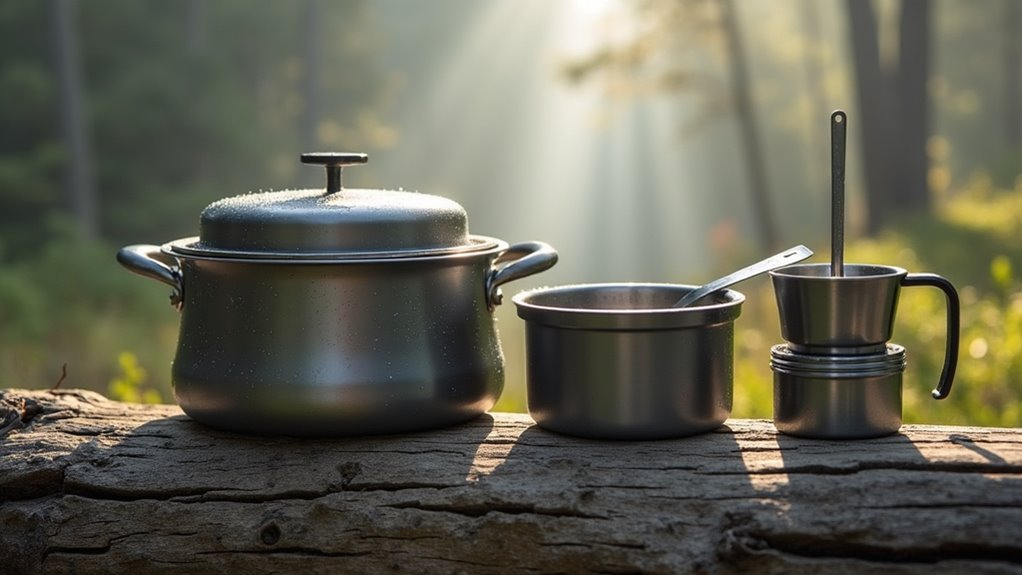Physical Address
304 North Cardinal St.
Dorchester Center, MA 02124
Physical Address
304 North Cardinal St.
Dorchester Center, MA 02124

Outdoor cooking success hinges on selecting the perfect camping cookware, but which pieces will truly elevate your wilderness meals?
When you’re cooking in the great outdoors, your gear can make or break your wilderness feast like a compass guides a traveler home. You’ll need to balance durability against weight, considering factors like group size, trip length, and cooking style. Whether you’re a minimalist backpacker or a campground chef, your choice of pots, pans, and utensils will shape every meal you create under the open sky. Let’s explore the essential elements that’ll transform your camp kitchen into a reliable culinary hub.

Five key features define exceptional camping cookware, making the difference between a successful outdoor cooking experience and a frustrating one.
You’ll want gear that’s portable and lightweight, with folding handles and nesting designs to maximize space in your pack. Many campers choose titanium cookware for its ultralight properties and corrosion resistance. Essential cooking gear is crucial for delicious camping meals.
Durability is essential – look for hard-anodized aluminum or stainless steel that can withstand outdoor abuse.
When camping, your cookware takes a beating. Hard-anodized aluminum and stainless steel construction ensures your gear survives the wilderness.
Choose versatile pieces that work on multiple heat sources and serve multiple functions, reducing the number of items you’ll carry.
Your cookware should be easy to clean, with non-stick surfaces that won’t trap food in hard-to-reach places.
Finally, consider heat distribution – you’ll need cookware that heats evenly and retains temperature well, especially when cooking over unpredictable camp fires or portable stoves.
When choosing cookware for your outdoor adventures, understanding the unique properties of different materials can greatly impact your camping experience.
Each material offers distinct advantages for different camping situations. Essential camping cookware is crucial for your outdoor adventures.
Titanium’s ultralight design makes it perfect for backpacking, though it’ll cost more than other options. Some titanium sets like the Snow Peak Ti-Mini are highly packable for efficient storage.
If you’re camping on a budget, aluminum provides excellent heat distribution and lightweight portability while remaining affordable.
For car camping where weight isn’t an issue, cast iron delivers unmatched durability and superior heat retention for open-flame cooking.
Hard-anodized aluminum strikes a balance between durability and weight, offering scratch resistance without the maintenance needs of cast iron.
While stainless steel is heavier, you’ll appreciate its rugged construction and minimal upkeep, though you’ll need to watch for hot spots during cooking.

Managing limited space efficiently ranks among the biggest challenges of camp cooking, especially for extended trips or group adventures.
Space management is crucial for successful camp cooking, particularly when planning longer trips or cooking for multiple people.
You’ll find nesting cookware sets particularly valuable, as they’re designed to fit compactly inside each other, greatly reducing packed volume.
For lightweight backpacking, opt for collapsible cookware and dinnerware that pack flat. The Frontier Ultralight Collapsible product line offers space-efficient solutions that fold down to a fraction of their full size.
If you’re car camping or overlanding, consider hard-shell storage boxes to protect your gear during transport.
Keep smaller items organized in mesh bags or elastic nets, which you can hang inside your tent or on your pack for easy access.
Make the most of available space by storing utensils and spice packets inside your pots. Essential camping gear can also help maximize your camp kitchen setup.
You can also maximize vertical space by using tent hooks for hanging lighter cookware and implementing multi-use solutions like tables with built-in storage.
Selecting the right cookware set for group camping can make or break your outdoor cooking experience. When you’re cooking for a crowd, you’ll need to focus on large-capacity options that can handle substantial meals while remaining portable.
The GSI Glacier Stainless Troop Cookset distinguishes itself as a top choice for large groups, offering both durability and ample cooking space. The set includes an impressive 8.5 qt. stainless steel pot along with additional pieces perfect for group meal preparation.
If you’re looking for versatility, consider the Stanley Adventure Base Camp 4, which includes multiple components for different cooking needs. For lighter trips, the Primus Campfire Cookset provides a more streamlined solution. Mastering the art of camp cooking can help you make the most of your outdoor culinary adventures.
Choose your material wisely – stainless steel offers durability, titanium provides lightweight efficiency, and non-stick surfaces make cleanup easier.
Don’t forget to match your cookware to your cooking method, whether you’re using an open flame or camping stove.

While group camping requires extensive cookware setups, solo adventurers face a different challenge: finding the perfect balance between minimalism and functionality.
You should aim to focus on lightweight, compact options that don’t sacrifice cooking versatility. Essential cookware tips can help guide your selection.
Start with a 1-liter pot for boiling water and one-pot meals, paired with a 6-inch frying pan for basic cooking tasks. If you’re backpacking, consider titanium cookware for its exceptional strength-to-weight ratio. For car camping, aluminum or stainless steel options offer durability at a lower cost. A silicone-coated handle design ensures safe and comfortable cooking without burns.
Titanium cookware excels for lightweight backpacking, while aluminum or steel options serve car campers well at a budget-friendly price point.
Look for cookware with folding handles and nesting capabilities to save space in your pack. A well-designed mess kit can provide all your essentials in one compact package.
Don’t forget to prioritize non-stick surfaces or smooth finishes for easier cleanup in the backcountry.
To battle the unpredictable forces of nature, you’ll need cookware that can withstand everything from driving rain to howling winds. Your best choices are titanium and hard-anodized aluminum, which resist corrosion while remaining lightweight and quick-drying.
For stability in windy conditions, consider stainless steel or cast iron, but remember they’ll add significant weight to your pack. The rust-proof stainless steel in products like the Glacier Mess Kit makes them particularly reliable for extended outdoor use.
When camping in cold weather, stick to metal cookware, as plastic can become brittle and crack. Look for sets with tight-fitting lids and insulated handles to protect your food and hands from the elements.
Choose cookware with nesting capabilities to save space and protect your equipment. A weatherproof storage bag will shield your gear between uses, ensuring it’s ready for your next adventure.

Popular camping cookware brands offer distinct advantages that align with different outdoor cooking needs.
Stanley’s advanced Even-Heat technology and stainless steel construction make it perfect if you’re seeking consistent cooking results. For easy cleanup and food release, MSR’s ceramic non-stick cookware is your best bet. At 2 pounds 15 ounces, the Primus Campfire Cookset offers an excellent weight-to-capacity ratio for backpackers.
GSI Outdoors excels in durability with their stainless steel camper sets, while Primus delivers value-focused options ideal for group camping. Essential Tips for Choosing Camping Cookware can help you determine the best cookware for your needs.
If you’re passionate about traditional outdoor cooking, Lodge’s cast iron products provide unmatched heat retention and durability.
When considering materials, you’ll find stainless steel offers superior scratch resistance, ceramic non-stick ensures effortless food release, and cast iron delivers exceptional heat distribution.
The choice ultimately depends on your cooking style, group size, and whether you prioritize features like even heating or simple cleanup.
Maintaining your camp cookware requires three essential practices: proper cleaning, thorough drying, and careful storage.
You should aim to rinse your cookware immediately after use, using biodegradable soap and warm water for most items, but only water for cast iron. Keep metal utensils away from non-stick surfaces to prevent scratching. Using a two-bin system for washing and rinsing dishes makes cleanup more efficient and organized.
After cleaning, dry your cookware completely to prevent rust and mold. For cast iron, apply a light coat of cooking oil before storing. Essential tools for delicious campfire cooking can make your camp meals even more enjoyable.
When packing, use soft liners or cloth wraps to protect surfaces, and store items in ventilated containers. Remember to follow Leave No Trace principles by cleaning cookware at least 200 feet from water sources and properly disposing of waste water.
Regular inspection for wear and damage will help extend your cookware’s lifespan.

With your cookware properly maintained, the next decision you’ll face is whether to invest in a complete cookset or build your collection piece by piece.
Complete sets offer efficient nesting for compact storage and typically include everything you’ll need at a better value. You’ll get pots, pans, and often plates or mugs that fit together seamlessly, making them ideal for group camping trips. Options like the Stanley Base Camp cater perfectly to groups of four with its 21-piece set.
However, if you’re particular about your cooking style or focused on minimizing weight, selecting individual pieces might be your better option. You can choose exactly what you need, mix materials like lightweight aluminum for some items and cast iron for others, and replace single pieces when needed. Mastering camp cooking in your outdoor kitchen can be achieved with either complete sets or individual pieces.
Consider your camping style – car camping suits complete sets, while backpacking often benefits from carefully selected individual pieces.
Just as a seasoned hiker knows every ounce counts, you’ll find that selecting the right camping cookware can make or break your outdoor kitchen experience. When you’re balancing durability against weight – like choosing between a 12-ounce titanium pot versus a 32-ounce steel one – remember that quality gear is an investment in countless memorable meals under the stars. Choose wisely, maintain diligently, and you’ll create outdoor feasts for years to come.